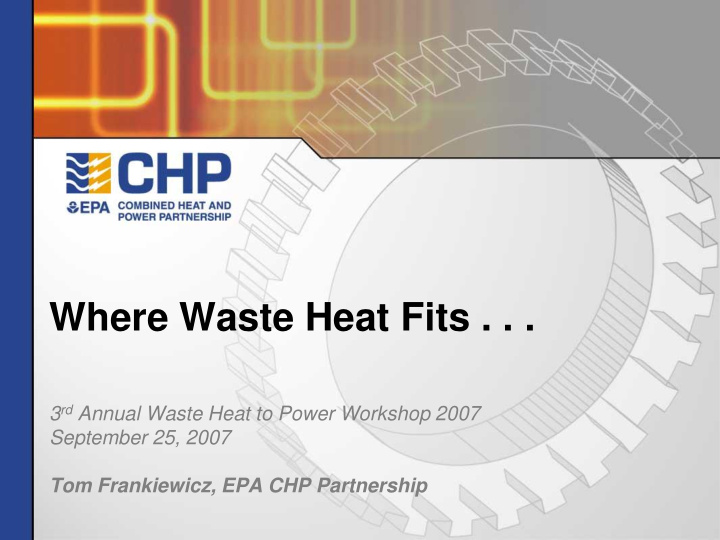



Where Waste Heat Fits . . . 3 rd Annual Waste Heat to Power Workshop 2007 September 25, 2007 Tom Frankiewicz, EPA CHP Partnership
within Combined Heat and Power? • Generation of Heat and Power from a single fuel source • Captures “waste” heat • Similar barriers and drivers • Similar equipment • Similar community
within Clean Energy? • EPA has consistently supported clean energy – energy efficiency, renewable energy, and distributed generation as effective Greenhouse Gas reduction strategy • Waste heat to power fits squarely within this strategy
Benefits of Clean Energy (EE, RE, and DG) • Economic – Lower cost compared to new generation and transmission – Downward pressure on natural gas prices “ Clean Energy” – Lower wholesale electricity prices includes cost- effective energy – Improved local economy efficiency (EE), – Improved service to low income and seniors renewable energy • Risk Management (RE), and clean – Diversify a utility’s generation supply portfolio distributed – Reduce environmental regulatory risk to utilities generation (DG) • such as combined Environmental heat and power – Lower greenhouse gas emissions and air pollutants (CHP). – Lower water use • Utility System Benefits – Quick fix with longer term benefits – Improved security of electricity and gas systems – Lower peak demand / improved reliability
within a Greenhouse Gas Reduction Strategy? • Displaces fossil fuel use • Effective and economic greenhouse gas reduction measure • Consistently cited as top measure by state and local regulatory initiatives as well as regional and corporate voluntary initiatives
Global and Local Benefits • Efficiency gains translate to emission reductions: – SO 2 – NO x • Commensurate greenhouse gas reductions.
Recognizing Environmental Benefit • Key to encouraging CHP-DG & waste heat recovery is in recognizing its primary benefits: – Higher efficiency – Onsite thermal and electrical generation (avoid transmission & distribution losses) – State-of-the-art technology (emission offsets)
Monetizing Environmental Benefits Environmental Revenue Streams: Any number of programs that reward clean power generation and provide one time or ongoing revenue source. Emissions Programs • Emission allowance trading programs (cap and trade) • New source emission offset programs • CO 2 offset programs Generation Programs • Energy portfolio standard programs • Voluntary green power purchases
Supporting Projects • Procurement Guide • CHP Emissions Calculator • Funding Database
Waste Heat is Starting to Get Recognition • 10 State Renewable Portfolio Standards - 3 specifically call out waste heat • 2005 Energy Policy Act & New FERC Regs • AB 1613 “Waste Heat and Carbon Emissions Reduction Act.” • Self Generation Incentive Program • House Energy Bill • Other state efforts to improve interconnection practices and other policies that facilitate EE
The EPA CHP Partnership • Voluntary program - seeks to reduce the environmental impact of power generation by promoting the use of CHP. • Actively providing education/outreach and direct project assistance since 2001. • Provide services and tools for Partners to assist with CHP project development, regulatory barriers, market transformation. • Work with government and environmental community to evaluate environmental benefits of CHP.
Resources for Greenhouse Gas Reductions
CHP Partnership Tom Frankiewicz frankiewicz.thomas@epa.gov 202.343.9794 Or visit our website at www.epa.gov/chp
Recommend
More recommend